Financial Management Report: Morrison's and Financial Strategies
VerifiedAdded on 2023/01/11
|25
|6339
|2
Report
AI Summary
This report delves into the core principles of financial management, exploring various approaches and techniques used in effective decision-making within organizations. It evaluates formal and informal decision-making methods, knowledge-based approaches, and the make-or-buy decision-making process. The report also examines stakeholder management strategies, emphasizing the importance of aligning objectives, ethical financial management, maximizing shareholder wealth, and achieving sustainable growth. Furthermore, it analyzes the value of management accounting techniques, including budgetary control and standard costing, in cost control and performance evaluation. The report also covers fraud detection and prevention techniques, such as internal controls, auditing, and ethical considerations. In addition, the report includes a financial ratio analysis of Morrison Supermarkets PLC for the years 2020, 2019, and 2018, and applies the data obtained in decision-making, investment appraisal techniques, and recommendations to improve financial sustainability.
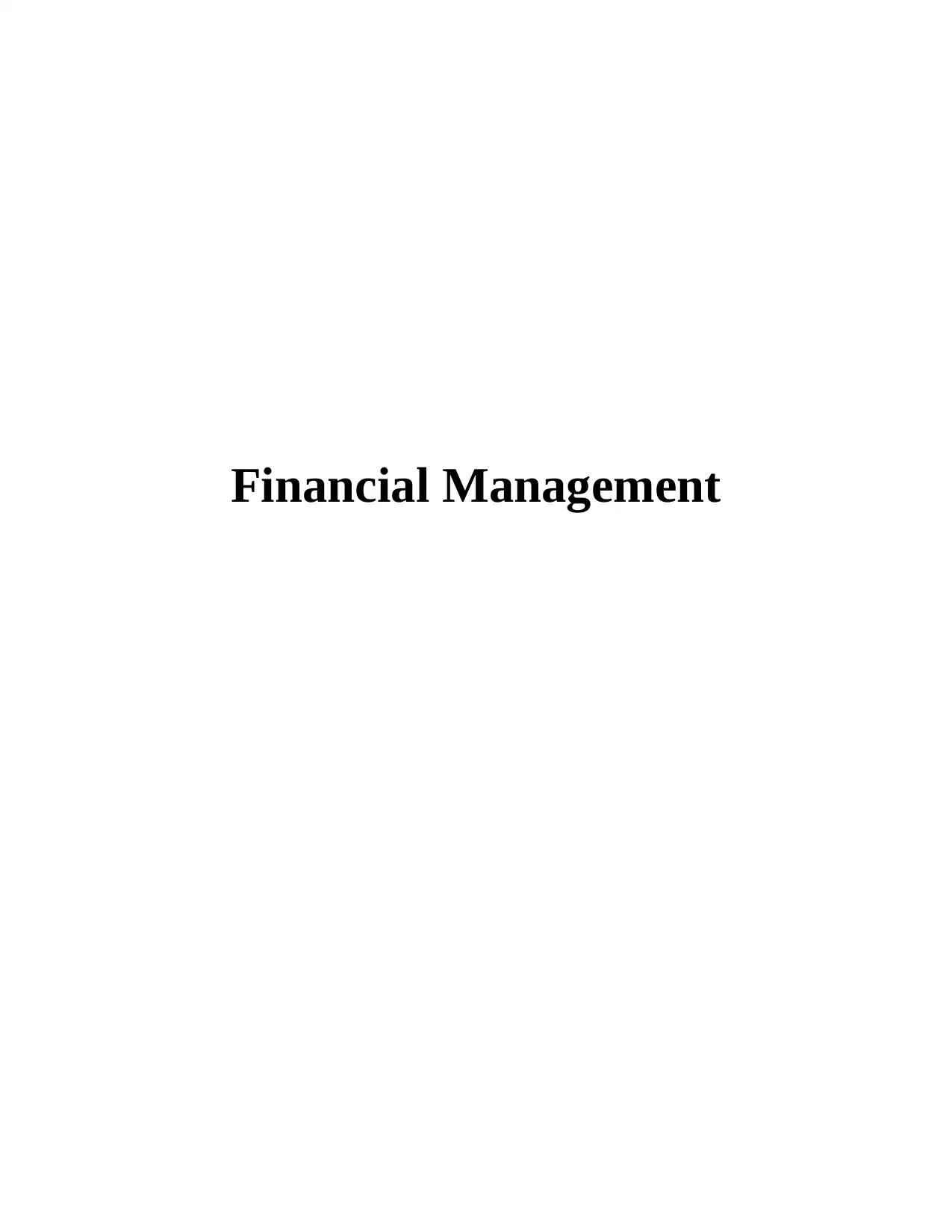
Financial Management
Paraphrase This Document
Need a fresh take? Get an instant paraphrase of this document with our AI Paraphraser
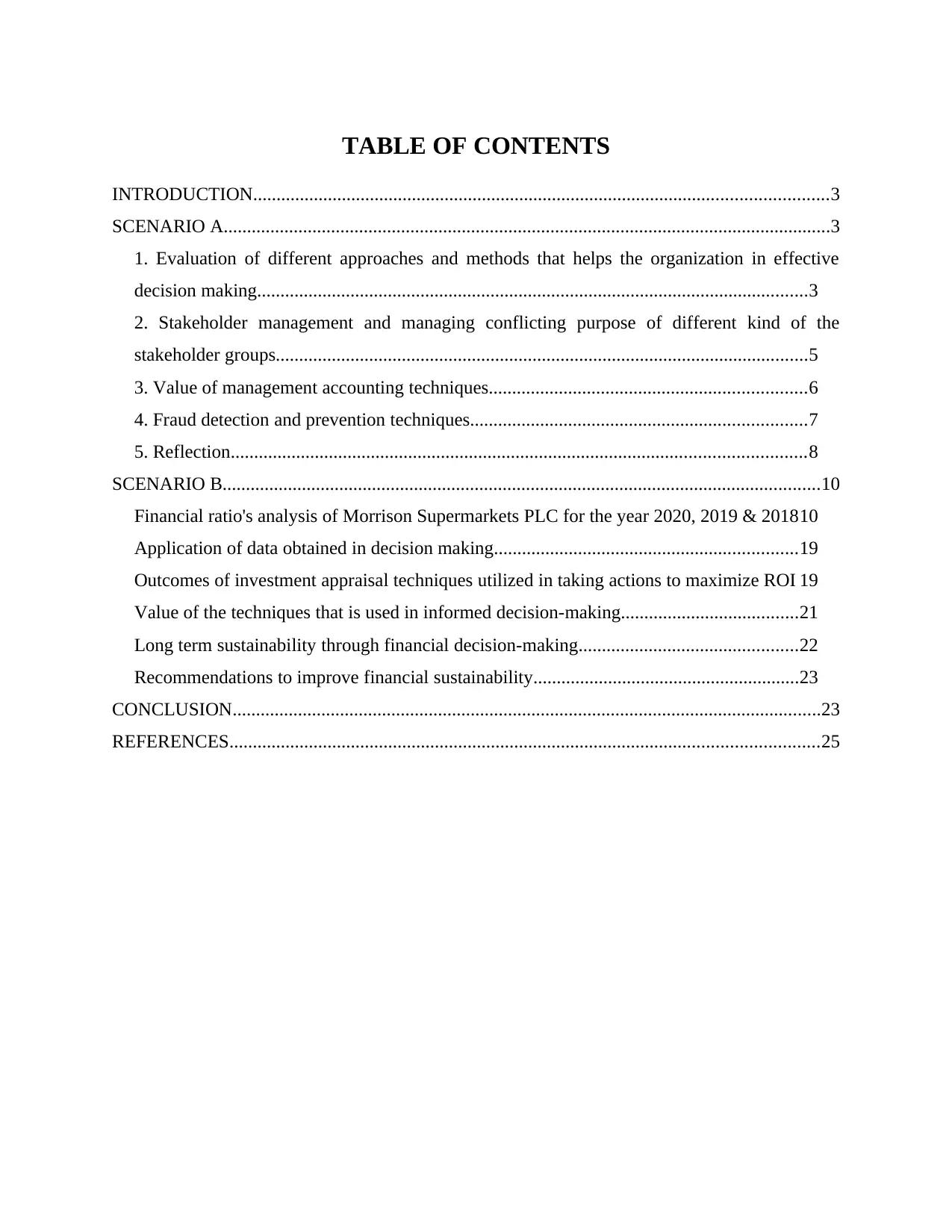
TABLE OF CONTENTS
INTRODUCTION...........................................................................................................................3
SCENARIO A..................................................................................................................................3
1. Evaluation of different approaches and methods that helps the organization in effective
decision making......................................................................................................................3
2. Stakeholder management and managing conflicting purpose of different kind of the
stakeholder groups..................................................................................................................5
3. Value of management accounting techniques....................................................................6
4. Fraud detection and prevention techniques........................................................................7
5. Reflection...........................................................................................................................8
SCENARIO B................................................................................................................................10
Financial ratio's analysis of Morrison Supermarkets PLC for the year 2020, 2019 & 201810
Application of data obtained in decision making.................................................................19
Outcomes of investment appraisal techniques utilized in taking actions to maximize ROI 19
Value of the techniques that is used in informed decision-making......................................21
Long term sustainability through financial decision-making...............................................22
Recommendations to improve financial sustainability.........................................................23
CONCLUSION..............................................................................................................................23
REFERENCES..............................................................................................................................25
INTRODUCTION...........................................................................................................................3
SCENARIO A..................................................................................................................................3
1. Evaluation of different approaches and methods that helps the organization in effective
decision making......................................................................................................................3
2. Stakeholder management and managing conflicting purpose of different kind of the
stakeholder groups..................................................................................................................5
3. Value of management accounting techniques....................................................................6
4. Fraud detection and prevention techniques........................................................................7
5. Reflection...........................................................................................................................8
SCENARIO B................................................................................................................................10
Financial ratio's analysis of Morrison Supermarkets PLC for the year 2020, 2019 & 201810
Application of data obtained in decision making.................................................................19
Outcomes of investment appraisal techniques utilized in taking actions to maximize ROI 19
Value of the techniques that is used in informed decision-making......................................21
Long term sustainability through financial decision-making...............................................22
Recommendations to improve financial sustainability.........................................................23
CONCLUSION..............................................................................................................................23
REFERENCES..............................................................................................................................25
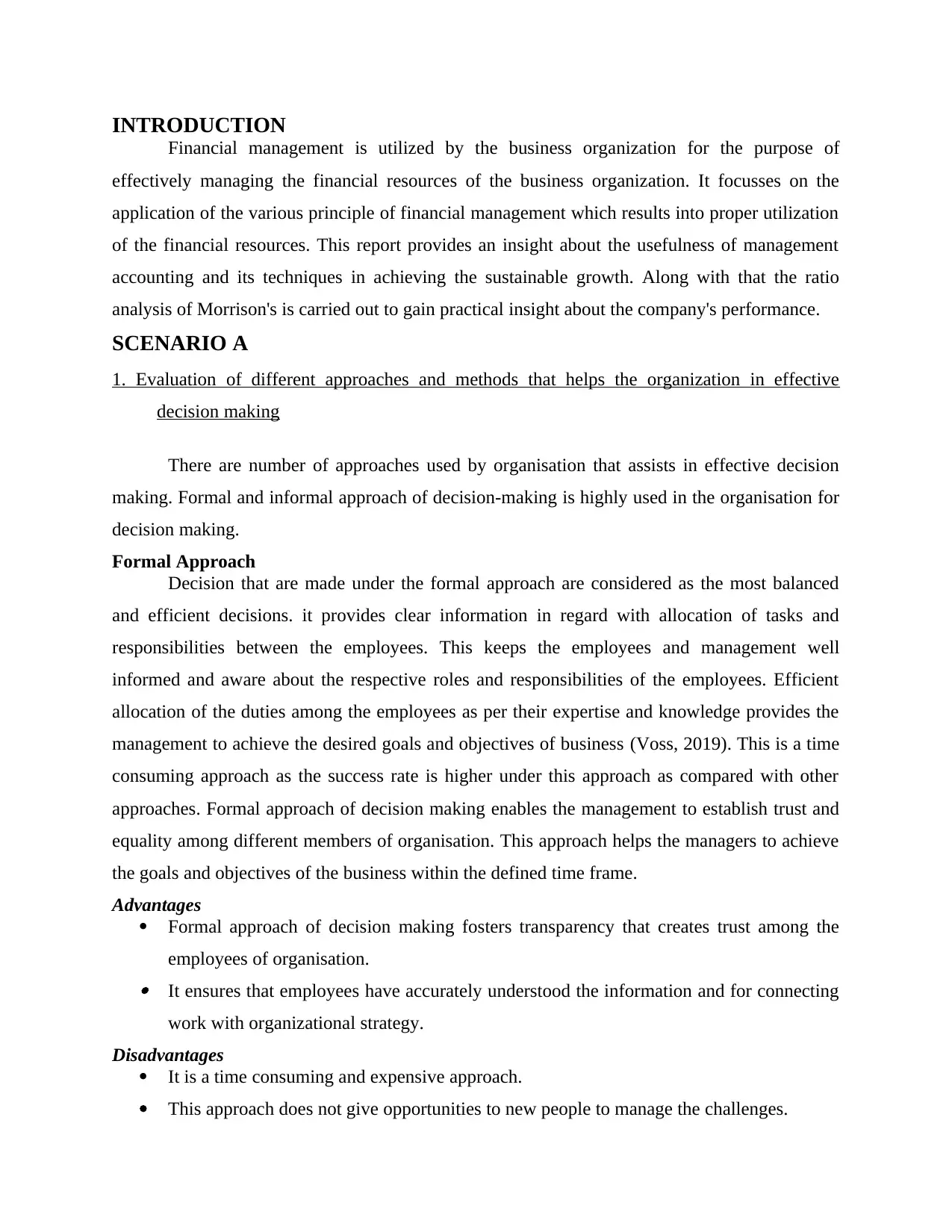
INTRODUCTION
Financial management is utilized by the business organization for the purpose of
effectively managing the financial resources of the business organization. It focusses on the
application of the various principle of financial management which results into proper utilization
of the financial resources. This report provides an insight about the usefulness of management
accounting and its techniques in achieving the sustainable growth. Along with that the ratio
analysis of Morrison's is carried out to gain practical insight about the company's performance.
SCENARIO A
1. Evaluation of different approaches and methods that helps the organization in effective
decision making
There are number of approaches used by organisation that assists in effective decision
making. Formal and informal approach of decision-making is highly used in the organisation for
decision making.
Formal Approach
Decision that are made under the formal approach are considered as the most balanced
and efficient decisions. it provides clear information in regard with allocation of tasks and
responsibilities between the employees. This keeps the employees and management well
informed and aware about the respective roles and responsibilities of the employees. Efficient
allocation of the duties among the employees as per their expertise and knowledge provides the
management to achieve the desired goals and objectives of business (Voss, 2019). This is a time
consuming approach as the success rate is higher under this approach as compared with other
approaches. Formal approach of decision making enables the management to establish trust and
equality among different members of organisation. This approach helps the managers to achieve
the goals and objectives of the business within the defined time frame.
Advantages
Formal approach of decision making fosters transparency that creates trust among the
employees of organisation. It ensures that employees have accurately understood the information and for connecting
work with organizational strategy.
Disadvantages
It is a time consuming and expensive approach.
This approach does not give opportunities to new people to manage the challenges.
Financial management is utilized by the business organization for the purpose of
effectively managing the financial resources of the business organization. It focusses on the
application of the various principle of financial management which results into proper utilization
of the financial resources. This report provides an insight about the usefulness of management
accounting and its techniques in achieving the sustainable growth. Along with that the ratio
analysis of Morrison's is carried out to gain practical insight about the company's performance.
SCENARIO A
1. Evaluation of different approaches and methods that helps the organization in effective
decision making
There are number of approaches used by organisation that assists in effective decision
making. Formal and informal approach of decision-making is highly used in the organisation for
decision making.
Formal Approach
Decision that are made under the formal approach are considered as the most balanced
and efficient decisions. it provides clear information in regard with allocation of tasks and
responsibilities between the employees. This keeps the employees and management well
informed and aware about the respective roles and responsibilities of the employees. Efficient
allocation of the duties among the employees as per their expertise and knowledge provides the
management to achieve the desired goals and objectives of business (Voss, 2019). This is a time
consuming approach as the success rate is higher under this approach as compared with other
approaches. Formal approach of decision making enables the management to establish trust and
equality among different members of organisation. This approach helps the managers to achieve
the goals and objectives of the business within the defined time frame.
Advantages
Formal approach of decision making fosters transparency that creates trust among the
employees of organisation. It ensures that employees have accurately understood the information and for connecting
work with organizational strategy.
Disadvantages
It is a time consuming and expensive approach.
This approach does not give opportunities to new people to manage the challenges.
⊘ This is a preview!⊘
Do you want full access?
Subscribe today to unlock all pages.

Trusted by 1+ million students worldwide
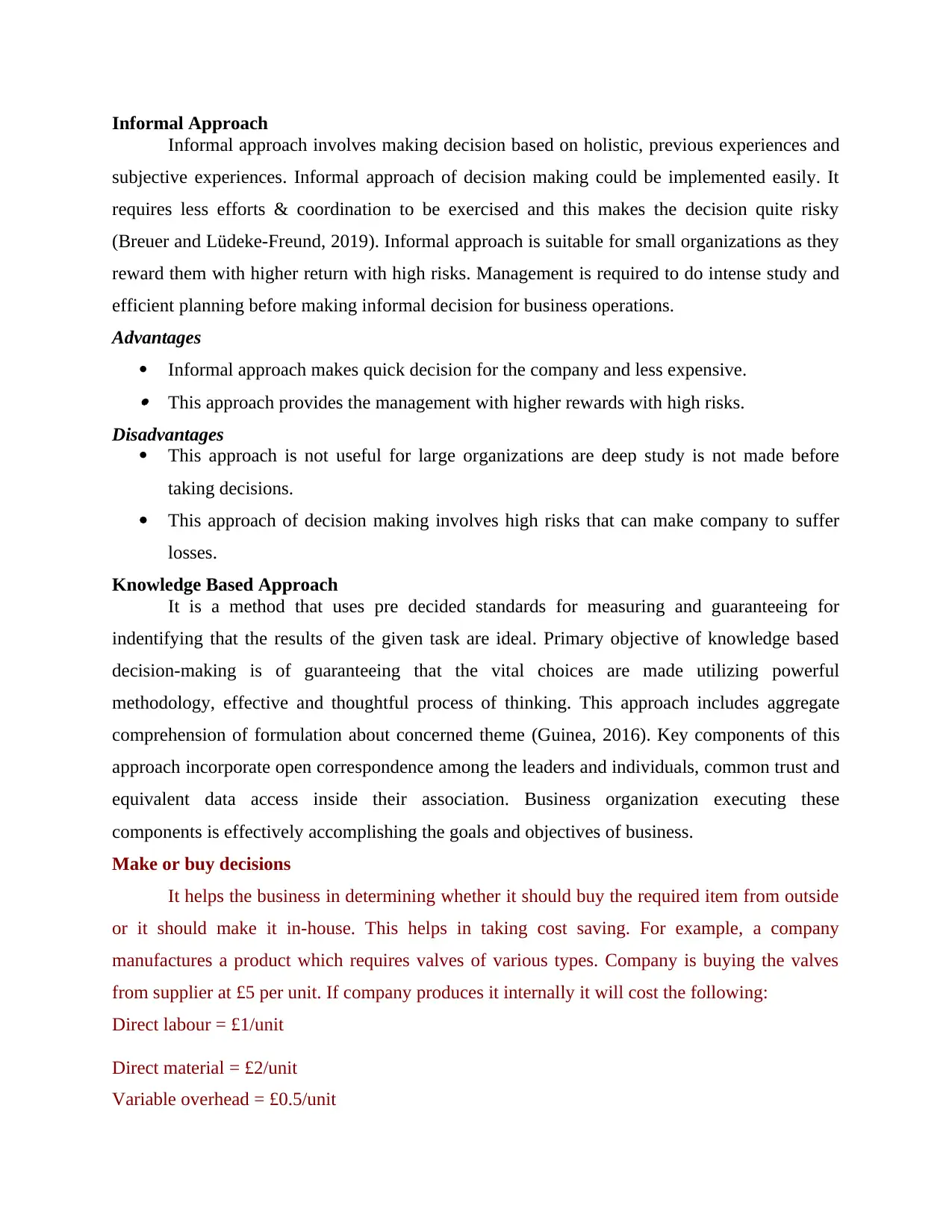
Informal Approach
Informal approach involves making decision based on holistic, previous experiences and
subjective experiences. Informal approach of decision making could be implemented easily. It
requires less efforts & coordination to be exercised and this makes the decision quite risky
(Breuer and Lüdeke-Freund, 2019). Informal approach is suitable for small organizations as they
reward them with higher return with high risks. Management is required to do intense study and
efficient planning before making informal decision for business operations.
Advantages
Informal approach makes quick decision for the company and less expensive. This approach provides the management with higher rewards with high risks.
Disadvantages
This approach is not useful for large organizations are deep study is not made before
taking decisions.
This approach of decision making involves high risks that can make company to suffer
losses.
Knowledge Based Approach
It is a method that uses pre decided standards for measuring and guaranteeing for
indentifying that the results of the given task are ideal. Primary objective of knowledge based
decision-making is of guaranteeing that the vital choices are made utilizing powerful
methodology, effective and thoughtful process of thinking. This approach includes aggregate
comprehension of formulation about concerned theme (Guinea, 2016). Key components of this
approach incorporate open correspondence among the leaders and individuals, common trust and
equivalent data access inside their association. Business organization executing these
components is effectively accomplishing the goals and objectives of business.
Make or buy decisions
It helps the business in determining whether it should buy the required item from outside
or it should make it in-house. This helps in taking cost saving. For example, a company
manufactures a product which requires valves of various types. Company is buying the valves
from supplier at £5 per unit. If company produces it internally it will cost the following:
Direct labour = £1/unit
Direct material = £2/unit
Variable overhead = £0.5/unit
Informal approach involves making decision based on holistic, previous experiences and
subjective experiences. Informal approach of decision making could be implemented easily. It
requires less efforts & coordination to be exercised and this makes the decision quite risky
(Breuer and Lüdeke-Freund, 2019). Informal approach is suitable for small organizations as they
reward them with higher return with high risks. Management is required to do intense study and
efficient planning before making informal decision for business operations.
Advantages
Informal approach makes quick decision for the company and less expensive. This approach provides the management with higher rewards with high risks.
Disadvantages
This approach is not useful for large organizations are deep study is not made before
taking decisions.
This approach of decision making involves high risks that can make company to suffer
losses.
Knowledge Based Approach
It is a method that uses pre decided standards for measuring and guaranteeing for
indentifying that the results of the given task are ideal. Primary objective of knowledge based
decision-making is of guaranteeing that the vital choices are made utilizing powerful
methodology, effective and thoughtful process of thinking. This approach includes aggregate
comprehension of formulation about concerned theme (Guinea, 2016). Key components of this
approach incorporate open correspondence among the leaders and individuals, common trust and
equivalent data access inside their association. Business organization executing these
components is effectively accomplishing the goals and objectives of business.
Make or buy decisions
It helps the business in determining whether it should buy the required item from outside
or it should make it in-house. This helps in taking cost saving. For example, a company
manufactures a product which requires valves of various types. Company is buying the valves
from supplier at £5 per unit. If company produces it internally it will cost the following:
Direct labour = £1/unit
Direct material = £2/unit
Variable overhead = £0.5/unit
Paraphrase This Document
Need a fresh take? Get an instant paraphrase of this document with our AI Paraphraser
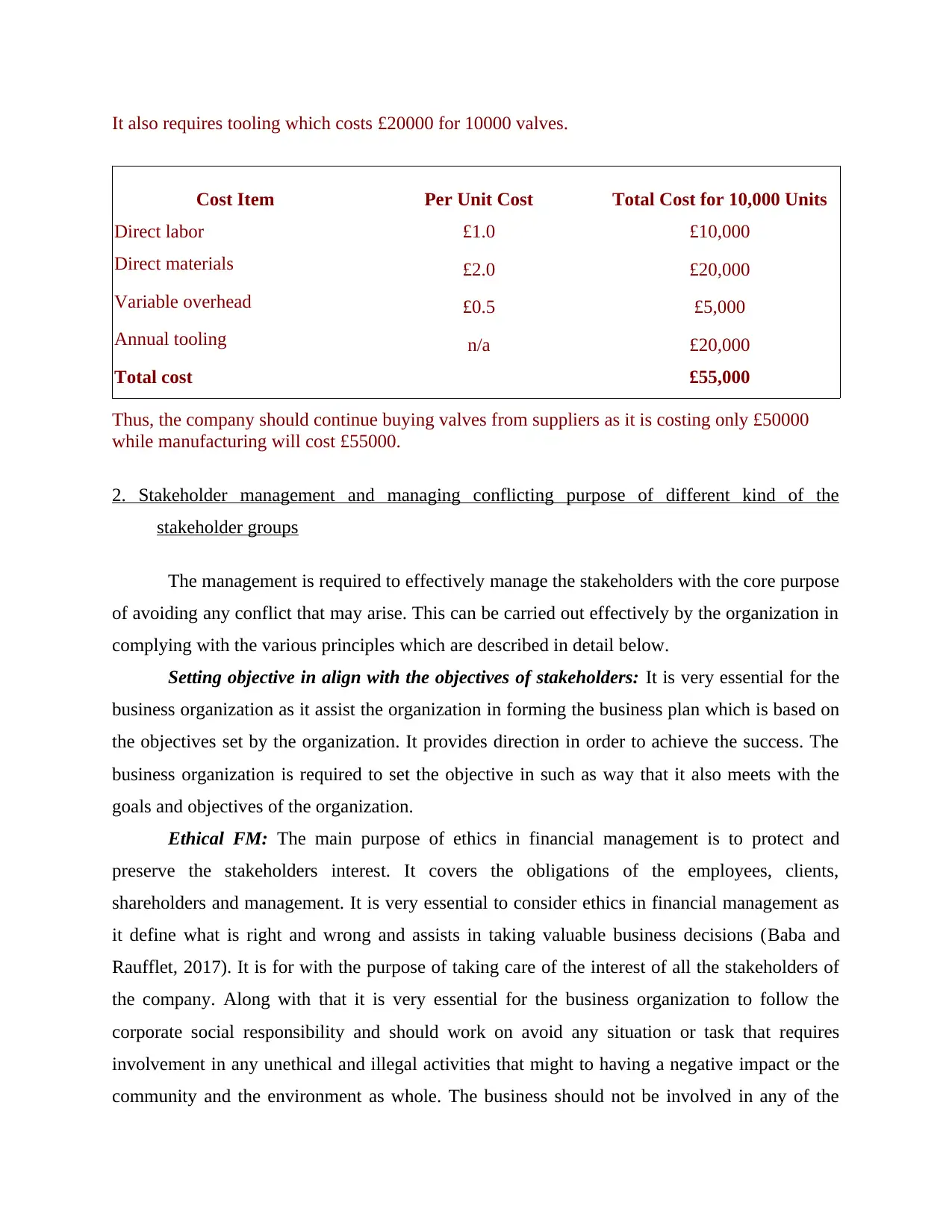
It also requires tooling which costs £20000 for 10000 valves.
Cost Item Per Unit Cost Total Cost for 10,000 Units
Direct labor £1.0 £10,000
Direct materials £2.0 £20,000
Variable overhead £0.5 £5,000
Annual tooling n/a £20,000
Total cost £55,000
Thus, the company should continue buying valves from suppliers as it is costing only £50000
while manufacturing will cost £55000.
2. Stakeholder management and managing conflicting purpose of different kind of the
stakeholder groups
The management is required to effectively manage the stakeholders with the core purpose
of avoiding any conflict that may arise. This can be carried out effectively by the organization in
complying with the various principles which are described in detail below.
Setting objective in align with the objectives of stakeholders: It is very essential for the
business organization as it assist the organization in forming the business plan which is based on
the objectives set by the organization. It provides direction in order to achieve the success. The
business organization is required to set the objective in such as way that it also meets with the
goals and objectives of the organization.
Ethical FM: The main purpose of ethics in financial management is to protect and
preserve the stakeholders interest. It covers the obligations of the employees, clients,
shareholders and management. It is very essential to consider ethics in financial management as
it define what is right and wrong and assists in taking valuable business decisions (Baba and
Raufflet, 2017). It is for with the purpose of taking care of the interest of all the stakeholders of
the company. Along with that it is very essential for the business organization to follow the
corporate social responsibility and should work on avoid any situation or task that requires
involvement in any unethical and illegal activities that might to having a negative impact or the
community and the environment as whole. The business should not be involved in any of the
Cost Item Per Unit Cost Total Cost for 10,000 Units
Direct labor £1.0 £10,000
Direct materials £2.0 £20,000
Variable overhead £0.5 £5,000
Annual tooling n/a £20,000
Total cost £55,000
Thus, the company should continue buying valves from suppliers as it is costing only £50000
while manufacturing will cost £55000.
2. Stakeholder management and managing conflicting purpose of different kind of the
stakeholder groups
The management is required to effectively manage the stakeholders with the core purpose
of avoiding any conflict that may arise. This can be carried out effectively by the organization in
complying with the various principles which are described in detail below.
Setting objective in align with the objectives of stakeholders: It is very essential for the
business organization as it assist the organization in forming the business plan which is based on
the objectives set by the organization. It provides direction in order to achieve the success. The
business organization is required to set the objective in such as way that it also meets with the
goals and objectives of the organization.
Ethical FM: The main purpose of ethics in financial management is to protect and
preserve the stakeholders interest. It covers the obligations of the employees, clients,
shareholders and management. It is very essential to consider ethics in financial management as
it define what is right and wrong and assists in taking valuable business decisions (Baba and
Raufflet, 2017). It is for with the purpose of taking care of the interest of all the stakeholders of
the company. Along with that it is very essential for the business organization to follow the
corporate social responsibility and should work on avoid any situation or task that requires
involvement in any unethical and illegal activities that might to having a negative impact or the
community and the environment as whole. The business should not be involved in any of the
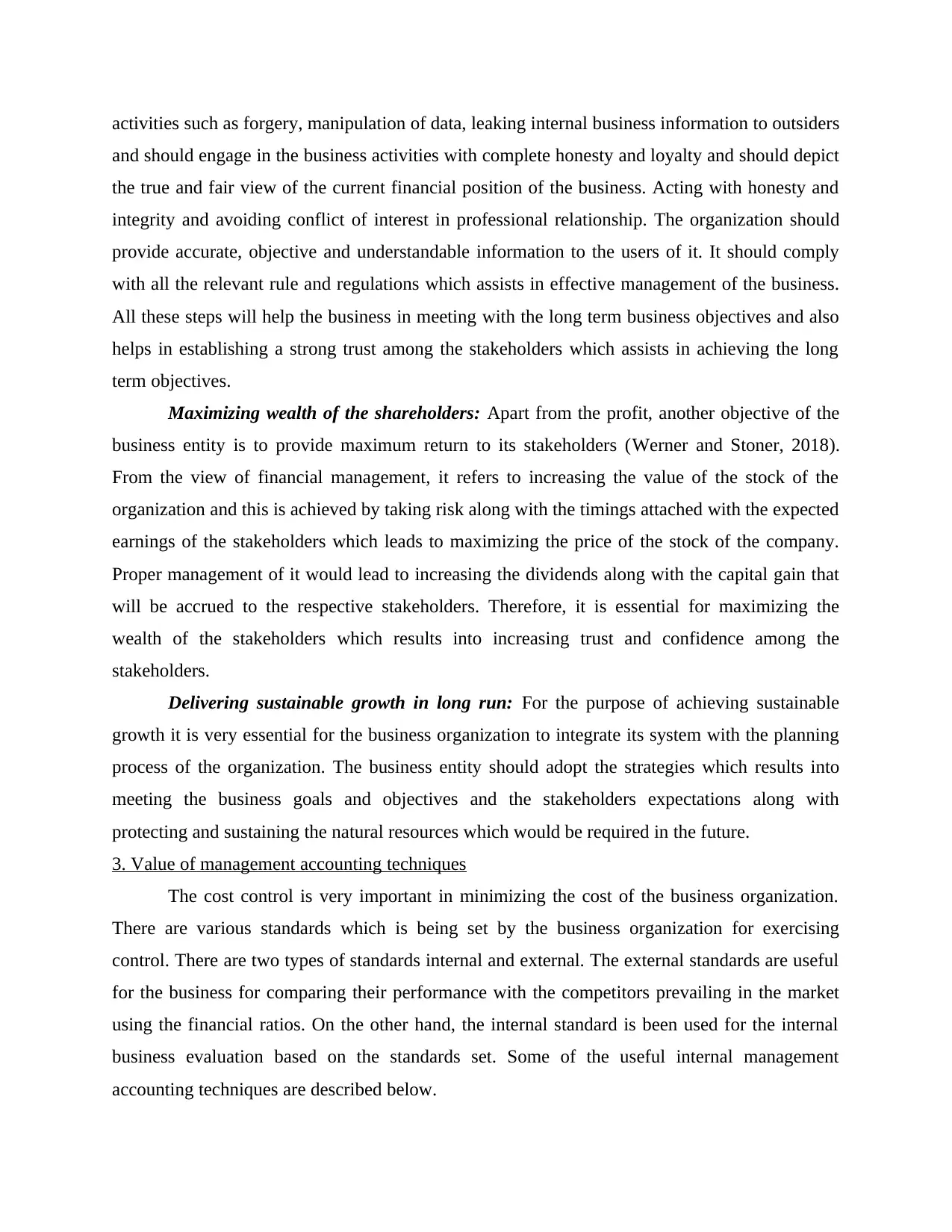
activities such as forgery, manipulation of data, leaking internal business information to outsiders
and should engage in the business activities with complete honesty and loyalty and should depict
the true and fair view of the current financial position of the business. Acting with honesty and
integrity and avoiding conflict of interest in professional relationship. The organization should
provide accurate, objective and understandable information to the users of it. It should comply
with all the relevant rule and regulations which assists in effective management of the business.
All these steps will help the business in meeting with the long term business objectives and also
helps in establishing a strong trust among the stakeholders which assists in achieving the long
term objectives.
Maximizing wealth of the shareholders: Apart from the profit, another objective of the
business entity is to provide maximum return to its stakeholders (Werner and Stoner, 2018).
From the view of financial management, it refers to increasing the value of the stock of the
organization and this is achieved by taking risk along with the timings attached with the expected
earnings of the stakeholders which leads to maximizing the price of the stock of the company.
Proper management of it would lead to increasing the dividends along with the capital gain that
will be accrued to the respective stakeholders. Therefore, it is essential for maximizing the
wealth of the stakeholders which results into increasing trust and confidence among the
stakeholders.
Delivering sustainable growth in long run: For the purpose of achieving sustainable
growth it is very essential for the business organization to integrate its system with the planning
process of the organization. The business entity should adopt the strategies which results into
meeting the business goals and objectives and the stakeholders expectations along with
protecting and sustaining the natural resources which would be required in the future.
3. Value of management accounting techniques
The cost control is very important in minimizing the cost of the business organization.
There are various standards which is being set by the business organization for exercising
control. There are two types of standards internal and external. The external standards are useful
for the business for comparing their performance with the competitors prevailing in the market
using the financial ratios. On the other hand, the internal standard is been used for the internal
business evaluation based on the standards set. Some of the useful internal management
accounting techniques are described below.
and should engage in the business activities with complete honesty and loyalty and should depict
the true and fair view of the current financial position of the business. Acting with honesty and
integrity and avoiding conflict of interest in professional relationship. The organization should
provide accurate, objective and understandable information to the users of it. It should comply
with all the relevant rule and regulations which assists in effective management of the business.
All these steps will help the business in meeting with the long term business objectives and also
helps in establishing a strong trust among the stakeholders which assists in achieving the long
term objectives.
Maximizing wealth of the shareholders: Apart from the profit, another objective of the
business entity is to provide maximum return to its stakeholders (Werner and Stoner, 2018).
From the view of financial management, it refers to increasing the value of the stock of the
organization and this is achieved by taking risk along with the timings attached with the expected
earnings of the stakeholders which leads to maximizing the price of the stock of the company.
Proper management of it would lead to increasing the dividends along with the capital gain that
will be accrued to the respective stakeholders. Therefore, it is essential for maximizing the
wealth of the stakeholders which results into increasing trust and confidence among the
stakeholders.
Delivering sustainable growth in long run: For the purpose of achieving sustainable
growth it is very essential for the business organization to integrate its system with the planning
process of the organization. The business entity should adopt the strategies which results into
meeting the business goals and objectives and the stakeholders expectations along with
protecting and sustaining the natural resources which would be required in the future.
3. Value of management accounting techniques
The cost control is very important in minimizing the cost of the business organization.
There are various standards which is being set by the business organization for exercising
control. There are two types of standards internal and external. The external standards are useful
for the business for comparing their performance with the competitors prevailing in the market
using the financial ratios. On the other hand, the internal standard is been used for the internal
business evaluation based on the standards set. Some of the useful internal management
accounting techniques are described below.
⊘ This is a preview!⊘
Do you want full access?
Subscribe today to unlock all pages.

Trusted by 1+ million students worldwide
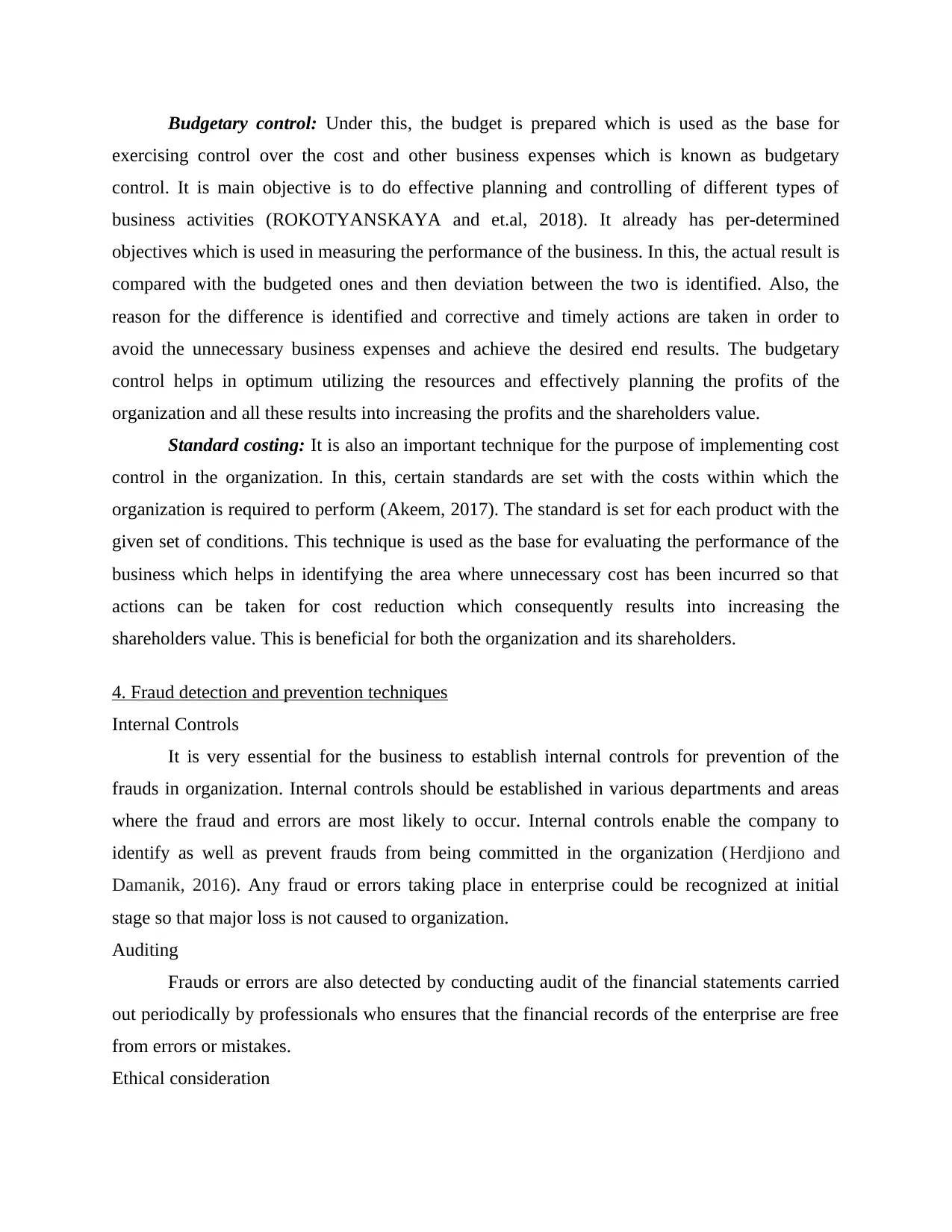
Budgetary control: Under this, the budget is prepared which is used as the base for
exercising control over the cost and other business expenses which is known as budgetary
control. It is main objective is to do effective planning and controlling of different types of
business activities (ROKOTYANSKAYA and et.al, 2018). It already has per-determined
objectives which is used in measuring the performance of the business. In this, the actual result is
compared with the budgeted ones and then deviation between the two is identified. Also, the
reason for the difference is identified and corrective and timely actions are taken in order to
avoid the unnecessary business expenses and achieve the desired end results. The budgetary
control helps in optimum utilizing the resources and effectively planning the profits of the
organization and all these results into increasing the profits and the shareholders value.
Standard costing: It is also an important technique for the purpose of implementing cost
control in the organization. In this, certain standards are set with the costs within which the
organization is required to perform (Akeem, 2017). The standard is set for each product with the
given set of conditions. This technique is used as the base for evaluating the performance of the
business which helps in identifying the area where unnecessary cost has been incurred so that
actions can be taken for cost reduction which consequently results into increasing the
shareholders value. This is beneficial for both the organization and its shareholders.
4. Fraud detection and prevention techniques
Internal Controls
It is very essential for the business to establish internal controls for prevention of the
frauds in organization. Internal controls should be established in various departments and areas
where the fraud and errors are most likely to occur. Internal controls enable the company to
identify as well as prevent frauds from being committed in the organization (Herdjiono and
Damanik, 2016). Any fraud or errors taking place in enterprise could be recognized at initial
stage so that major loss is not caused to organization.
Auditing
Frauds or errors are also detected by conducting audit of the financial statements carried
out periodically by professionals who ensures that the financial records of the enterprise are free
from errors or mistakes.
Ethical consideration
exercising control over the cost and other business expenses which is known as budgetary
control. It is main objective is to do effective planning and controlling of different types of
business activities (ROKOTYANSKAYA and et.al, 2018). It already has per-determined
objectives which is used in measuring the performance of the business. In this, the actual result is
compared with the budgeted ones and then deviation between the two is identified. Also, the
reason for the difference is identified and corrective and timely actions are taken in order to
avoid the unnecessary business expenses and achieve the desired end results. The budgetary
control helps in optimum utilizing the resources and effectively planning the profits of the
organization and all these results into increasing the profits and the shareholders value.
Standard costing: It is also an important technique for the purpose of implementing cost
control in the organization. In this, certain standards are set with the costs within which the
organization is required to perform (Akeem, 2017). The standard is set for each product with the
given set of conditions. This technique is used as the base for evaluating the performance of the
business which helps in identifying the area where unnecessary cost has been incurred so that
actions can be taken for cost reduction which consequently results into increasing the
shareholders value. This is beneficial for both the organization and its shareholders.
4. Fraud detection and prevention techniques
Internal Controls
It is very essential for the business to establish internal controls for prevention of the
frauds in organization. Internal controls should be established in various departments and areas
where the fraud and errors are most likely to occur. Internal controls enable the company to
identify as well as prevent frauds from being committed in the organization (Herdjiono and
Damanik, 2016). Any fraud or errors taking place in enterprise could be recognized at initial
stage so that major loss is not caused to organization.
Auditing
Frauds or errors are also detected by conducting audit of the financial statements carried
out periodically by professionals who ensures that the financial records of the enterprise are free
from errors or mistakes.
Ethical consideration
Paraphrase This Document
Need a fresh take? Get an instant paraphrase of this document with our AI Paraphraser
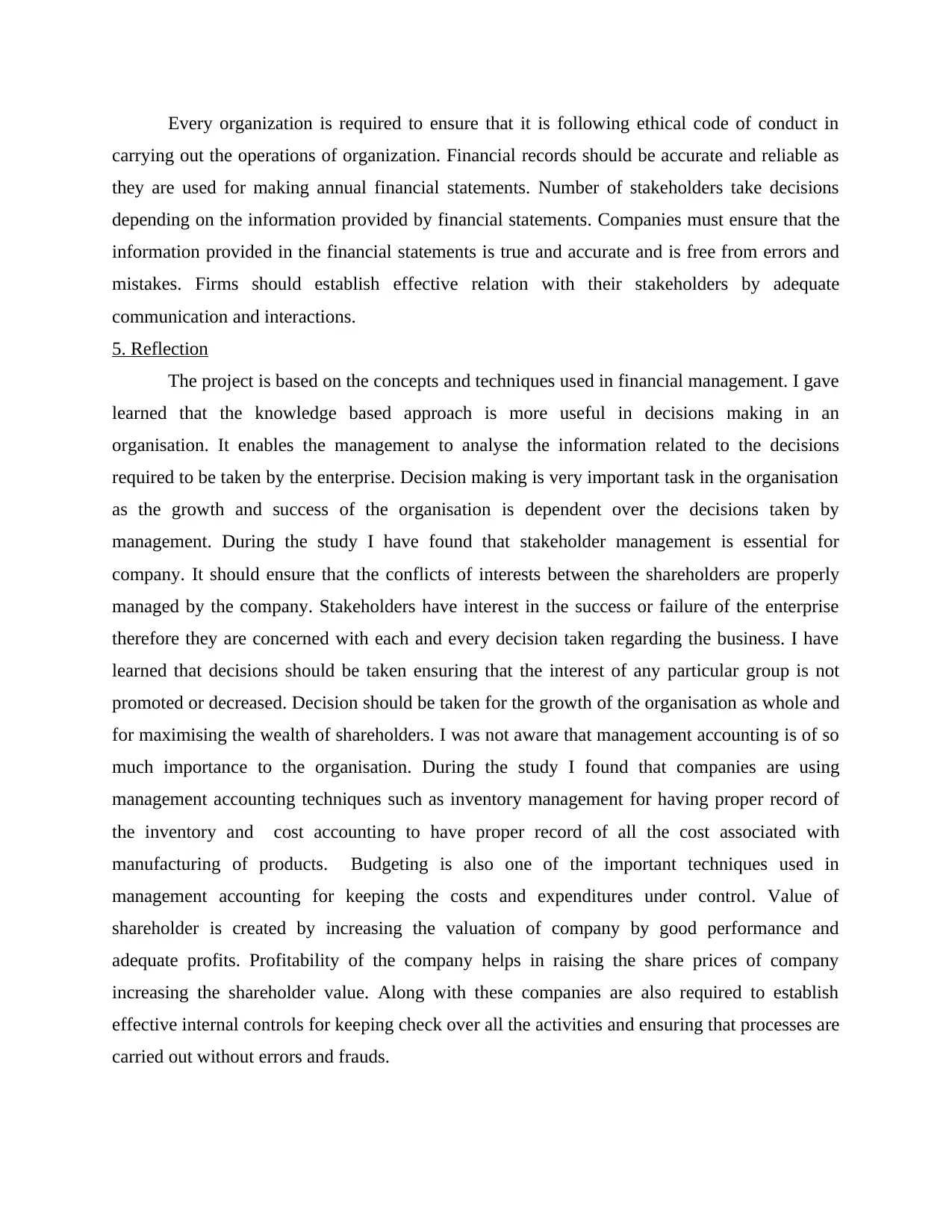
Every organization is required to ensure that it is following ethical code of conduct in
carrying out the operations of organization. Financial records should be accurate and reliable as
they are used for making annual financial statements. Number of stakeholders take decisions
depending on the information provided by financial statements. Companies must ensure that the
information provided in the financial statements is true and accurate and is free from errors and
mistakes. Firms should establish effective relation with their stakeholders by adequate
communication and interactions.
5. Reflection
The project is based on the concepts and techniques used in financial management. I gave
learned that the knowledge based approach is more useful in decisions making in an
organisation. It enables the management to analyse the information related to the decisions
required to be taken by the enterprise. Decision making is very important task in the organisation
as the growth and success of the organisation is dependent over the decisions taken by
management. During the study I have found that stakeholder management is essential for
company. It should ensure that the conflicts of interests between the shareholders are properly
managed by the company. Stakeholders have interest in the success or failure of the enterprise
therefore they are concerned with each and every decision taken regarding the business. I have
learned that decisions should be taken ensuring that the interest of any particular group is not
promoted or decreased. Decision should be taken for the growth of the organisation as whole and
for maximising the wealth of shareholders. I was not aware that management accounting is of so
much importance to the organisation. During the study I found that companies are using
management accounting techniques such as inventory management for having proper record of
the inventory and cost accounting to have proper record of all the cost associated with
manufacturing of products. Budgeting is also one of the important techniques used in
management accounting for keeping the costs and expenditures under control. Value of
shareholder is created by increasing the valuation of company by good performance and
adequate profits. Profitability of the company helps in raising the share prices of company
increasing the shareholder value. Along with these companies are also required to establish
effective internal controls for keeping check over all the activities and ensuring that processes are
carried out without errors and frauds.
carrying out the operations of organization. Financial records should be accurate and reliable as
they are used for making annual financial statements. Number of stakeholders take decisions
depending on the information provided by financial statements. Companies must ensure that the
information provided in the financial statements is true and accurate and is free from errors and
mistakes. Firms should establish effective relation with their stakeholders by adequate
communication and interactions.
5. Reflection
The project is based on the concepts and techniques used in financial management. I gave
learned that the knowledge based approach is more useful in decisions making in an
organisation. It enables the management to analyse the information related to the decisions
required to be taken by the enterprise. Decision making is very important task in the organisation
as the growth and success of the organisation is dependent over the decisions taken by
management. During the study I have found that stakeholder management is essential for
company. It should ensure that the conflicts of interests between the shareholders are properly
managed by the company. Stakeholders have interest in the success or failure of the enterprise
therefore they are concerned with each and every decision taken regarding the business. I have
learned that decisions should be taken ensuring that the interest of any particular group is not
promoted or decreased. Decision should be taken for the growth of the organisation as whole and
for maximising the wealth of shareholders. I was not aware that management accounting is of so
much importance to the organisation. During the study I found that companies are using
management accounting techniques such as inventory management for having proper record of
the inventory and cost accounting to have proper record of all the cost associated with
manufacturing of products. Budgeting is also one of the important techniques used in
management accounting for keeping the costs and expenditures under control. Value of
shareholder is created by increasing the valuation of company by good performance and
adequate profits. Profitability of the company helps in raising the share prices of company
increasing the shareholder value. Along with these companies are also required to establish
effective internal controls for keeping check over all the activities and ensuring that processes are
carried out without errors and frauds.
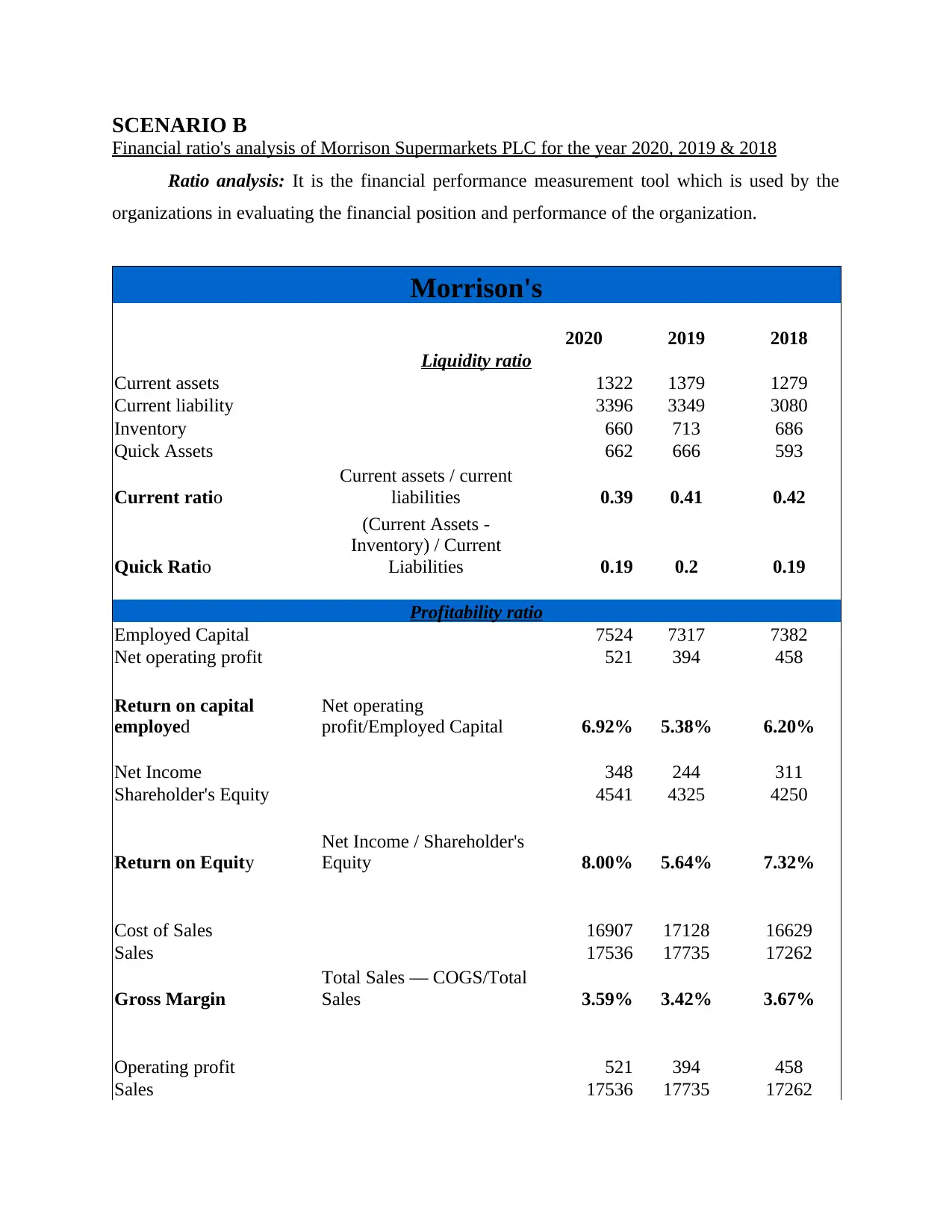
SCENARIO B
Financial ratio's analysis of Morrison Supermarkets PLC for the year 2020, 2019 & 2018
Ratio analysis: It is the financial performance measurement tool which is used by the
organizations in evaluating the financial position and performance of the organization.
Morrison's
2020 2019 2018
Liquidity ratio
Current assets 1322 1379 1279
Current liability 3396 3349 3080
Inventory 660 713 686
Quick Assets 662 666 593
Current ratio
Current assets / current
liabilities 0.39 0.41 0.42
Quick Ratio
(Current Assets -
Inventory) / Current
Liabilities 0.19 0.2 0.19
Profitability ratio
Employed Capital 7524 7317 7382
Net operating profit 521 394 458
Return on capital
employed
Net operating
profit/Employed Capital 6.92% 5.38% 6.20%
Net Income 348 244 311
Shareholder's Equity 4541 4325 4250
Return on Equity
Net Income / Shareholder's
Equity 8.00% 5.64% 7.32%
Cost of Sales 16907 17128 16629
Sales 17536 17735 17262
Gross Margin
Total Sales — COGS/Total
Sales 3.59% 3.42% 3.67%
Operating profit 521 394 458
Sales 17536 17735 17262
Financial ratio's analysis of Morrison Supermarkets PLC for the year 2020, 2019 & 2018
Ratio analysis: It is the financial performance measurement tool which is used by the
organizations in evaluating the financial position and performance of the organization.
Morrison's
2020 2019 2018
Liquidity ratio
Current assets 1322 1379 1279
Current liability 3396 3349 3080
Inventory 660 713 686
Quick Assets 662 666 593
Current ratio
Current assets / current
liabilities 0.39 0.41 0.42
Quick Ratio
(Current Assets -
Inventory) / Current
Liabilities 0.19 0.2 0.19
Profitability ratio
Employed Capital 7524 7317 7382
Net operating profit 521 394 458
Return on capital
employed
Net operating
profit/Employed Capital 6.92% 5.38% 6.20%
Net Income 348 244 311
Shareholder's Equity 4541 4325 4250
Return on Equity
Net Income / Shareholder's
Equity 8.00% 5.64% 7.32%
Cost of Sales 16907 17128 16629
Sales 17536 17735 17262
Gross Margin
Total Sales — COGS/Total
Sales 3.59% 3.42% 3.67%
Operating profit 521 394 458
Sales 17536 17735 17262
⊘ This is a preview!⊘
Do you want full access?
Subscribe today to unlock all pages.

Trusted by 1+ million students worldwide
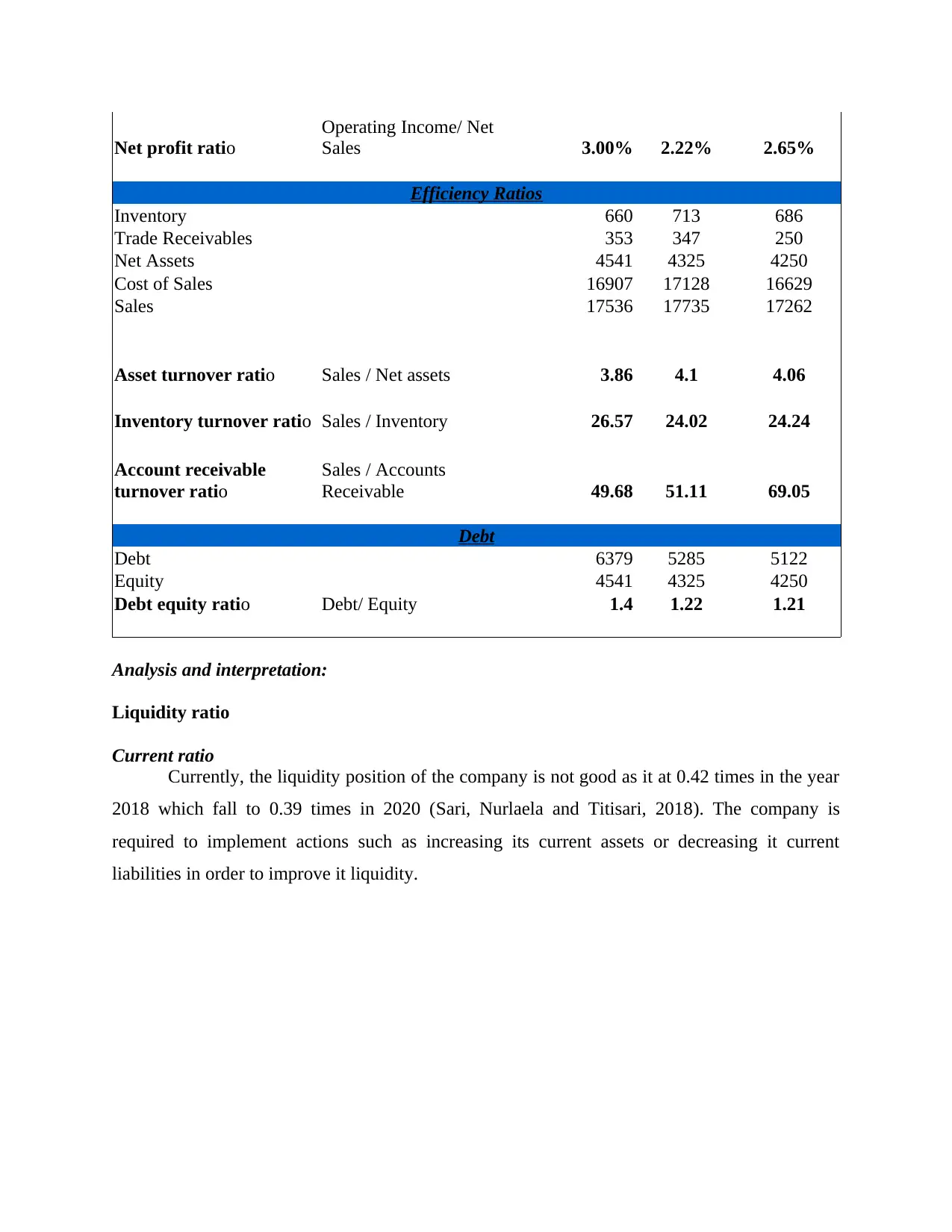
Net profit ratio
Operating Income/ Net
Sales 3.00% 2.22% 2.65%
Efficiency Ratios
Inventory 660 713 686
Trade Receivables 353 347 250
Net Assets 4541 4325 4250
Cost of Sales 16907 17128 16629
Sales 17536 17735 17262
Asset turnover ratio Sales / Net assets 3.86 4.1 4.06
Inventory turnover ratio Sales / Inventory 26.57 24.02 24.24
Account receivable
turnover ratio
Sales / Accounts
Receivable 49.68 51.11 69.05
Debt
Debt 6379 5285 5122
Equity 4541 4325 4250
Debt equity ratio Debt/ Equity 1.4 1.22 1.21
Analysis and interpretation:
Liquidity ratio
Current ratio
Currently, the liquidity position of the company is not good as it at 0.42 times in the year
2018 which fall to 0.39 times in 2020 (Sari, Nurlaela and Titisari, 2018). The company is
required to implement actions such as increasing its current assets or decreasing it current
liabilities in order to improve it liquidity.
Operating Income/ Net
Sales 3.00% 2.22% 2.65%
Efficiency Ratios
Inventory 660 713 686
Trade Receivables 353 347 250
Net Assets 4541 4325 4250
Cost of Sales 16907 17128 16629
Sales 17536 17735 17262
Asset turnover ratio Sales / Net assets 3.86 4.1 4.06
Inventory turnover ratio Sales / Inventory 26.57 24.02 24.24
Account receivable
turnover ratio
Sales / Accounts
Receivable 49.68 51.11 69.05
Debt
Debt 6379 5285 5122
Equity 4541 4325 4250
Debt equity ratio Debt/ Equity 1.4 1.22 1.21
Analysis and interpretation:
Liquidity ratio
Current ratio
Currently, the liquidity position of the company is not good as it at 0.42 times in the year
2018 which fall to 0.39 times in 2020 (Sari, Nurlaela and Titisari, 2018). The company is
required to implement actions such as increasing its current assets or decreasing it current
liabilities in order to improve it liquidity.
Paraphrase This Document
Need a fresh take? Get an instant paraphrase of this document with our AI Paraphraser
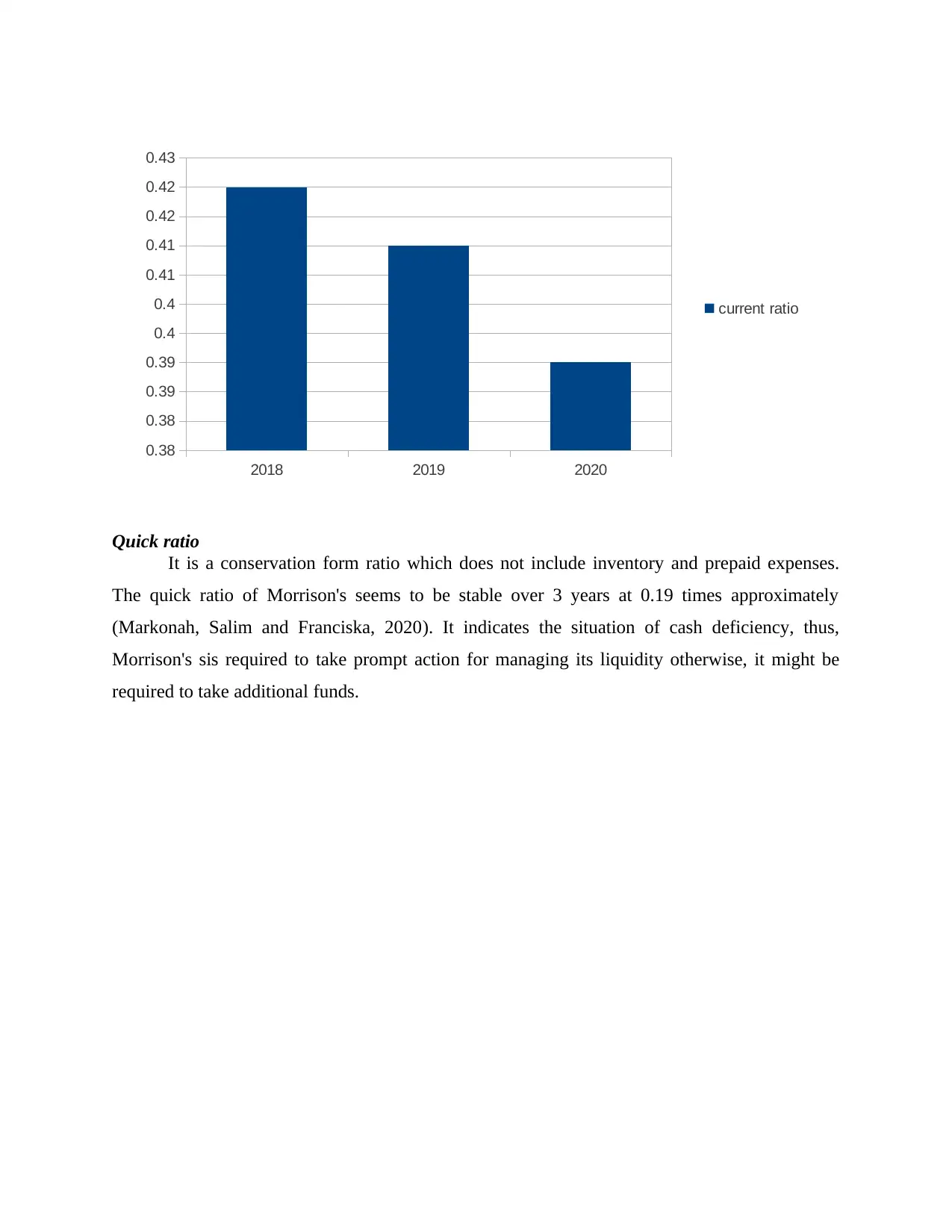
2018 2019 2020
0.38
0.38
0.39
0.39
0.4
0.4
0.41
0.41
0.42
0.42
0.43
current ratio
Quick ratio
It is a conservation form ratio which does not include inventory and prepaid expenses.
The quick ratio of Morrison's seems to be stable over 3 years at 0.19 times approximately
(Markonah, Salim and Franciska, 2020). It indicates the situation of cash deficiency, thus,
Morrison's sis required to take prompt action for managing its liquidity otherwise, it might be
required to take additional funds.
0.38
0.38
0.39
0.39
0.4
0.4
0.41
0.41
0.42
0.42
0.43
current ratio
Quick ratio
It is a conservation form ratio which does not include inventory and prepaid expenses.
The quick ratio of Morrison's seems to be stable over 3 years at 0.19 times approximately
(Markonah, Salim and Franciska, 2020). It indicates the situation of cash deficiency, thus,
Morrison's sis required to take prompt action for managing its liquidity otherwise, it might be
required to take additional funds.
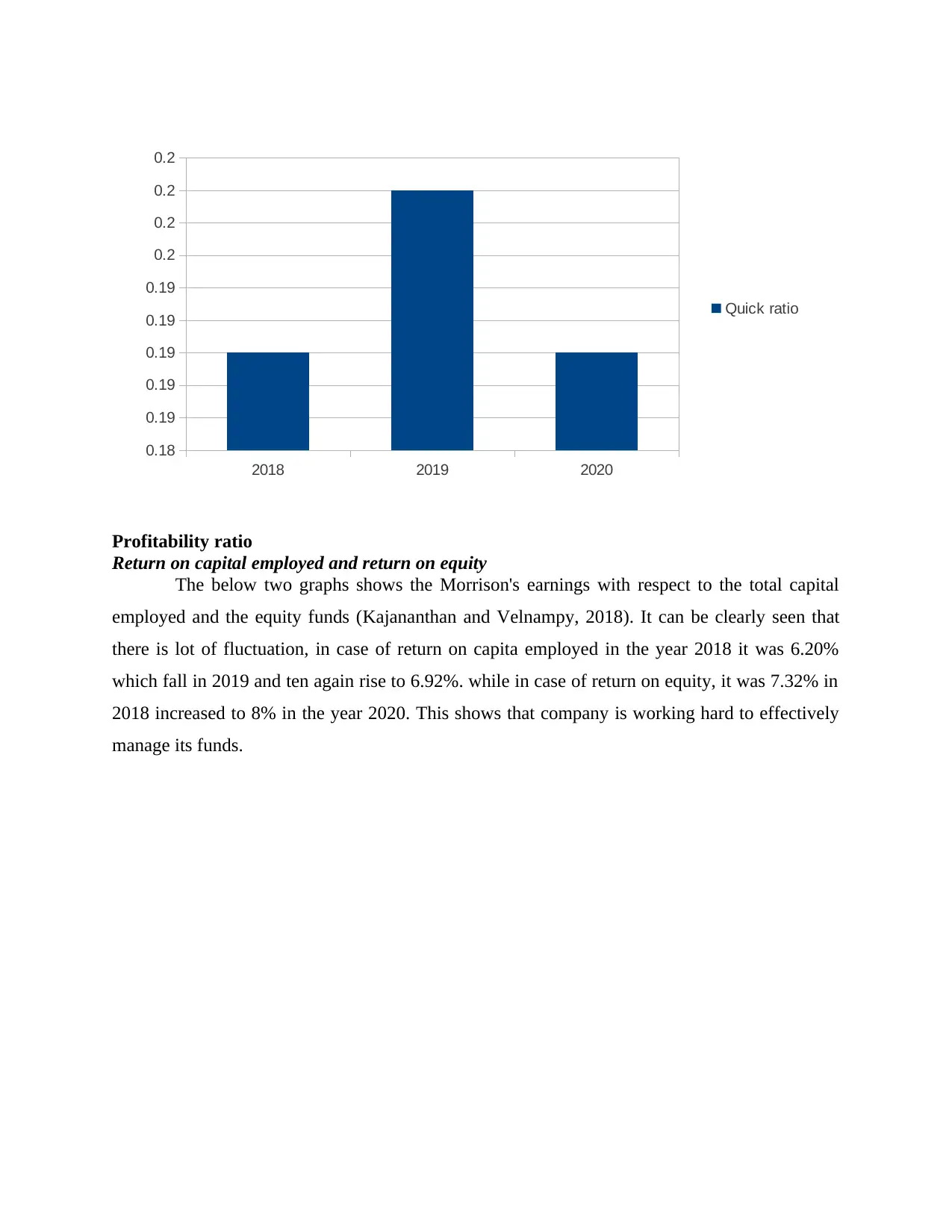
2018 2019 2020
0.18
0.19
0.19
0.19
0.19
0.19
0.2
0.2
0.2
0.2
Quick ratio
Profitability ratio
Return on capital employed and return on equity
The below two graphs shows the Morrison's earnings with respect to the total capital
employed and the equity funds (Kajananthan and Velnampy, 2018). It can be clearly seen that
there is lot of fluctuation, in case of return on capita employed in the year 2018 it was 6.20%
which fall in 2019 and ten again rise to 6.92%. while in case of return on equity, it was 7.32% in
2018 increased to 8% in the year 2020. This shows that company is working hard to effectively
manage its funds.
0.18
0.19
0.19
0.19
0.19
0.19
0.2
0.2
0.2
0.2
Quick ratio
Profitability ratio
Return on capital employed and return on equity
The below two graphs shows the Morrison's earnings with respect to the total capital
employed and the equity funds (Kajananthan and Velnampy, 2018). It can be clearly seen that
there is lot of fluctuation, in case of return on capita employed in the year 2018 it was 6.20%
which fall in 2019 and ten again rise to 6.92%. while in case of return on equity, it was 7.32% in
2018 increased to 8% in the year 2020. This shows that company is working hard to effectively
manage its funds.
⊘ This is a preview!⊘
Do you want full access?
Subscribe today to unlock all pages.

Trusted by 1+ million students worldwide
1 out of 25
Related Documents
Your All-in-One AI-Powered Toolkit for Academic Success.
+13062052269
info@desklib.com
Available 24*7 on WhatsApp / Email
![[object Object]](/_next/static/media/star-bottom.7253800d.svg)
Unlock your academic potential
Copyright © 2020–2025 A2Z Services. All Rights Reserved. Developed and managed by ZUCOL.





